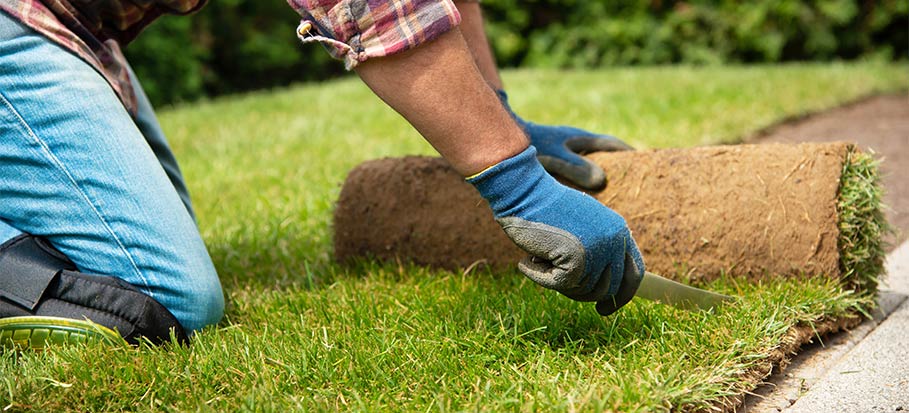
Laying turf, unlike other gardening operations, is not tied to any season. If you ask yourself when to lay turf – the answer is anytime as long as the soil is not frozen, too dry or soggy. Still, regarding timing, the rule of thumb is to lay it in Spring or Autumn when the weather is not too hot or too cold. If you live in mild weather conditions, then that’s the time when the soil has the perfect texture, and the correct balance of sun and rain make it easier to dig. Now that this is clear, we come to the question of how to lay turf the right way, of course. You see, with turf, the critical factor is preparation for the new lawn. And this post will cover exactly that. You’ll learn all the steps to follow about how to prepare and level the ground, what tools to use, and ultimately, you’ll find out the best way to lay turf.
- Planning your new lawn
- How to prepare the ground for new turf
- How to lay your new lawn
So, keep reading if you are:
- Considering giving a new lush look to your old lawn
- Wondering how to lay turf and how to prepare the soil
- Recently moved in and would like to transform the neglected garden
Planning your new lawn
There is one essential habit that every gardener has to adopt from the permaculture rules, even if you are not considering applying the whole concept of this gardening movement. Every action needs planning. When it comes down to landscaping your garden, always be sure to leave turf for last. You want to avoid working over your fresh, lush lawn while tending to other jobs.
When preparing for laying turf, consider your lawn’s shape and size and how much turf and soil you will need. Make sure the area you are looking to lay turf on is suitable. Consider mowing, shade and access to water. Also, an important and underlooked factor is drainage. When planning, ensure that no water will be sitting on the lawn.
Measure the space well and don’t skip preparation.
And don’t forget that turf has to be laid out immediately in Spring/Summer or 24 hours from Autumn/Winter delivery.
For tips on when to carry out other lawn and garden care jobs, read our helpful UK gardening calendar!
Recommended tools for laying turf
Give yourself an honest estimation of your labour – this way, you won’t be caught unprepared and with wrong expectations. If the condition of your soil calls for it and you are laying a new lawn over a poor-looking patch of grass – order a skip to remove the old turf. You will achieve the best results and save your back from strenuous labour if you use a lawn rotary hoe. The area prepared for the new lawn has to be dug evenly to a depth of 100mm to 150mm. This is done before you level the soil, in order to lay your new turf successfully.
A list of necessary tools:
- Wheelbarrow
- Rake for levelling
- Knife with a longer blade for trimming
- Spade or fork for breaking heavily impacted areas or a rotovator
- Scaffolding planks for kneeling on it, so you don’t disturb the prepared soil
- Garden hose and sprinkler
How to prepare the ground for new turf
When planning a new lawn, the first step is to kill and remove any existing poor-quality turf. We can’t stress enough on the importance of soil preparation before you create your new grassy area. Thorough digging and levelling of the ground will result in a healthy lawn for years to come.
To plan the digging job properly, consider the type of your soil. The time required will be different for the different soil types – for instance, clay soil might be harder to dig and get level. Ensure you allow yourself enough time and get your soil in tip-top condition before going ahead with the laying down process.
Follow these steps to prepare the ground for laying turf. It may take some time, but it’s time well spent if you want to create a lush healthy looking lawn.
Clear away plants, weeds and debris. Remove the existing lawn.
Although not impossible,it’s not recommended laying turf on existing grass as this will obstruct the solid rooting of the new grass. It’s essential not to underestimate this step. Otherwise, you might be risking old weeds peeking through the new lawn. Everything must go! If the area is too large – consider getting hold of a mechanical turf cutter.
There are two methods to remove an existing lawn.
Lifting the turf: This is the best way as the turf, you are removing, can make compost. Cut the old lawn with a turf cutter and lift the strips. If you can’t accommodate a compost at home, skip the old turf at your local household recycling centre.
Herbicides: To kill unwanted grass and weeds, make sure to select a herbicide that degrades quickly. This way, you will mitigate the risk of old weeds picking through your new turf but at the same time ensure that the ground is free of toxic chemicals sooner. It’s recommended to leave the weedkiller for approximately two weeks before you lay the new turf. This time will allow for the full effectiveness of the remaining residue to kill the unwanted weed.
Checking the quality and depth of your soil
The top soil’s ideal depth is between 100mm and 150mm – levelled and raked to a good tilt. You can also use an enriched-in-nutrients soil improver to boost growth and the healthy look of your new lawn. If you intend to purchase topsoil, some products offer a calculator for guidance on the right quantity of fertilised soil you’ll need.
Also, using a lawn fertiliser after the first couple of mows will help your new turf establish even better.
How to level the soil before laying turf
Laying turf is superior to planting seeds when it comes to quickly achieving new lush lawn. However, you still need to level the soil under the new layer. Levelling the soil before laying turf is the part that’s the most demanding to be done right for a long-lasting green lawn.
- First, inspect the terrain – gently walk up and down the area to identify unevenness.
- Begin with digging over to loosen up the soil.
- Rotovate heavily compacted areas and fill any dips, compressing evenly.
- Make sure to remove any stones, debris or perennial weeds.
- Once loosened, the ground is ready for getting lightly compacted – stomp it by walking. over it.
- Do not use a roller as the pressure will compact the soil too much.
- Finally, rake the soil to a fine tilth to ensure that the roots of your new turf establish well.
How to lay your new lawn
Congratulations – you’ve got to the easiest part of the job (and the most self-rewarding). As pointed out at the beginning of this article, make sure to lay the turf as soon as it is delivered. If it sits idle for days, especially in the summer, the turf will get burnt in the pallet and not survive.
Start by laying the strips of turf along a straight edge and gently firm down the sods with a wood piece to ensure contact between the underneath of the turf and your topsoil. Fill any cracks left with soil. Ensure you are using a scaffolding plank to walk on to prevent compacting the laid turf and to make sure that the remaining ground is level. Also, don’t forget to trim the ends of the turf to achieve that neat look of your new lawn.
Do you need help with laying your new turf?
Well, if you feel that you’re not up to the job, due to lack of time or skills, you can always call a professional landscaper to help you out. Fantastic Services delivers expert turf laying services with excellent results. We work with skilled and experienced landscapers, who can transform your green space by creating a lush new lawn for you to enjoy. Contact us and share your requests and we’ll handle the rest!
Need your turf professionally layed?
Schedule a survey with us and we’ll lay it perfectly !
- We’re certified:

Takeaways
- Place a plank when walking along the newly laid turf
- Never use a roller to level the ground as you are risking too high compression
- Never stretch the turf by pulling it – always push the strips of turf into a joint
- Lay turf as soon as possible after it has arrived – never allow it to dry out
- A good rule of thumbs is to order 5% more turf than you have calculated it’s needed
- Make sure that first-time mowing is done on a high setting, and all the turf has rooted in
- You probably know this, but watering should be done in the early morning to avoid the heat
***
Did you find our post helpful? Have you ever attempted to lay a new lawn by yourself? Why not tell us how you did in the comments below?
Image source: Shutterstock / Alexander Raths